Youth Homelessness: Exploring Causes, Consequences, and Interventions
VerifiedAdded on 2022/03/28
|6
|1360
|30
Report
AI Summary
This report delves into the multifaceted issue of youth homelessness in the United States. It explores various contributing factors, including family abuse, low-paying jobs, and involvement in the juvenile justice system. The report highlights the challenges homeless youths face, such as school difficulties, lack of access to housing services, and mental health issues. It examines the role of faith-based organizations like Covenant House in providing support and rehabilitation. Furthermore, it discusses the interconnectedness of homelessness with economic hardships and the COVID-19 pandemic. The report emphasizes the need for cooperation and creative solutions from youth justice authorities, service providers, and other stakeholders to improve outcomes for homeless adolescents. It concludes by underscoring the severity of youth homelessness as a critical social problem in the 21st century.

Running Head: YOUTH HOMELESSNESS 1
Youth Homelessness
Student’s Name
Institution
Instructor
Course
Date
Youth Homelessness
Student’s Name
Institution
Instructor
Course
Date
Paraphrase This Document
Need a fresh take? Get an instant paraphrase of this document with our AI Paraphraser
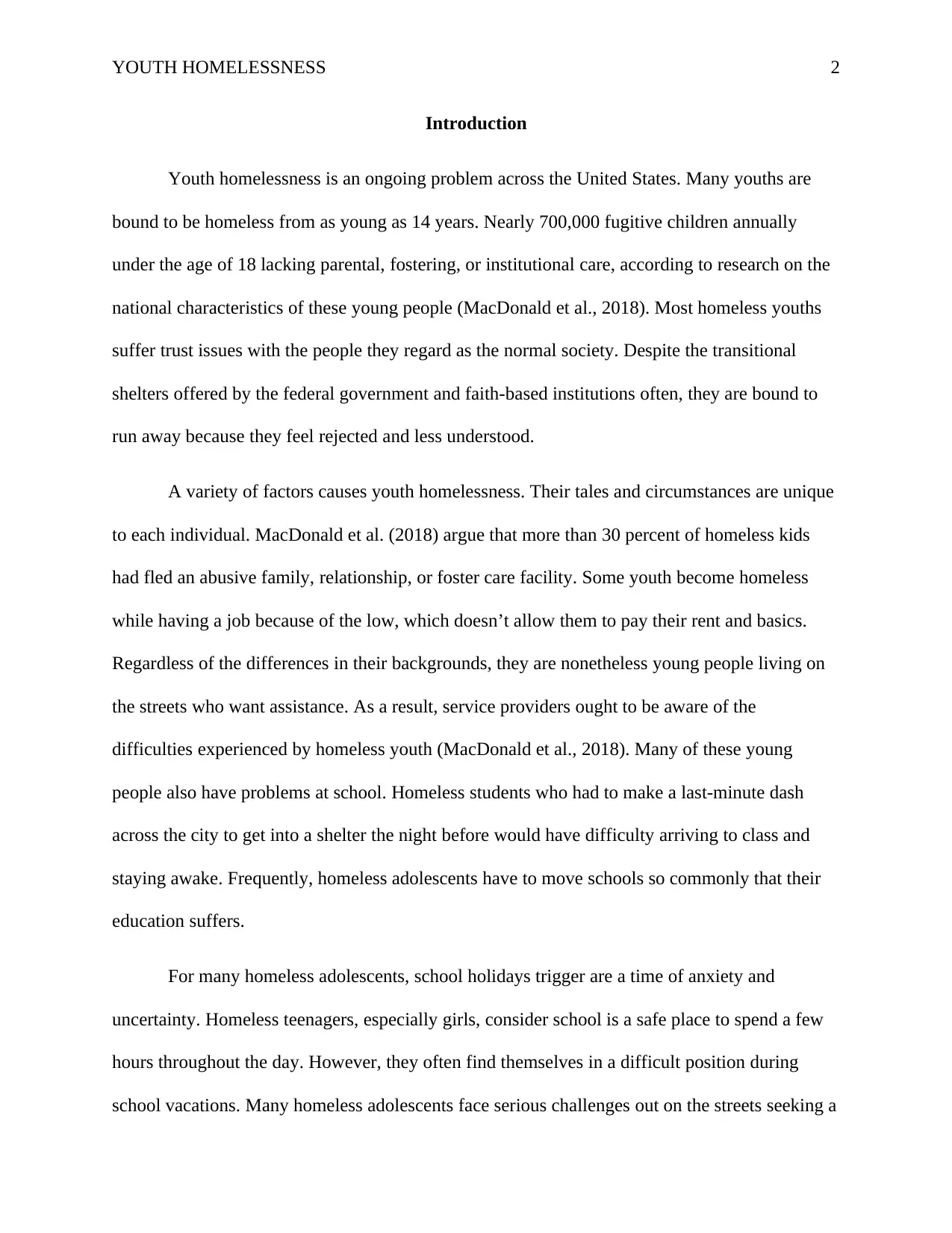
YOUTH HOMELESSNESS 2
Introduction
Youth homelessness is an ongoing problem across the United States. Many youths are
bound to be homeless from as young as 14 years. Nearly 700,000 fugitive children annually
under the age of 18 lacking parental, fostering, or institutional care, according to research on the
national characteristics of these young people (MacDonald et al., 2018). Most homeless youths
suffer trust issues with the people they regard as the normal society. Despite the transitional
shelters offered by the federal government and faith-based institutions often, they are bound to
run away because they feel rejected and less understood.
A variety of factors causes youth homelessness. Their tales and circumstances are unique
to each individual. MacDonald et al. (2018) argue that more than 30 percent of homeless kids
had fled an abusive family, relationship, or foster care facility. Some youth become homeless
while having a job because of the low, which doesn’t allow them to pay their rent and basics.
Regardless of the differences in their backgrounds, they are nonetheless young people living on
the streets who want assistance. As a result, service providers ought to be aware of the
difficulties experienced by homeless youth (MacDonald et al., 2018). Many of these young
people also have problems at school. Homeless students who had to make a last-minute dash
across the city to get into a shelter the night before would have difficulty arriving to class and
staying awake. Frequently, homeless adolescents have to move schools so commonly that their
education suffers.
For many homeless adolescents, school holidays trigger are a time of anxiety and
uncertainty. Homeless teenagers, especially girls, consider school is a safe place to spend a few
hours throughout the day. However, they often find themselves in a difficult position during
school vacations. Many homeless adolescents face serious challenges out on the streets seeking a
Introduction
Youth homelessness is an ongoing problem across the United States. Many youths are
bound to be homeless from as young as 14 years. Nearly 700,000 fugitive children annually
under the age of 18 lacking parental, fostering, or institutional care, according to research on the
national characteristics of these young people (MacDonald et al., 2018). Most homeless youths
suffer trust issues with the people they regard as the normal society. Despite the transitional
shelters offered by the federal government and faith-based institutions often, they are bound to
run away because they feel rejected and less understood.
A variety of factors causes youth homelessness. Their tales and circumstances are unique
to each individual. MacDonald et al. (2018) argue that more than 30 percent of homeless kids
had fled an abusive family, relationship, or foster care facility. Some youth become homeless
while having a job because of the low, which doesn’t allow them to pay their rent and basics.
Regardless of the differences in their backgrounds, they are nonetheless young people living on
the streets who want assistance. As a result, service providers ought to be aware of the
difficulties experienced by homeless youth (MacDonald et al., 2018). Many of these young
people also have problems at school. Homeless students who had to make a last-minute dash
across the city to get into a shelter the night before would have difficulty arriving to class and
staying awake. Frequently, homeless adolescents have to move schools so commonly that their
education suffers.
For many homeless adolescents, school holidays trigger are a time of anxiety and
uncertainty. Homeless teenagers, especially girls, consider school is a safe place to spend a few
hours throughout the day. However, they often find themselves in a difficult position during
school vacations. Many homeless adolescents face serious challenges out on the streets seeking a
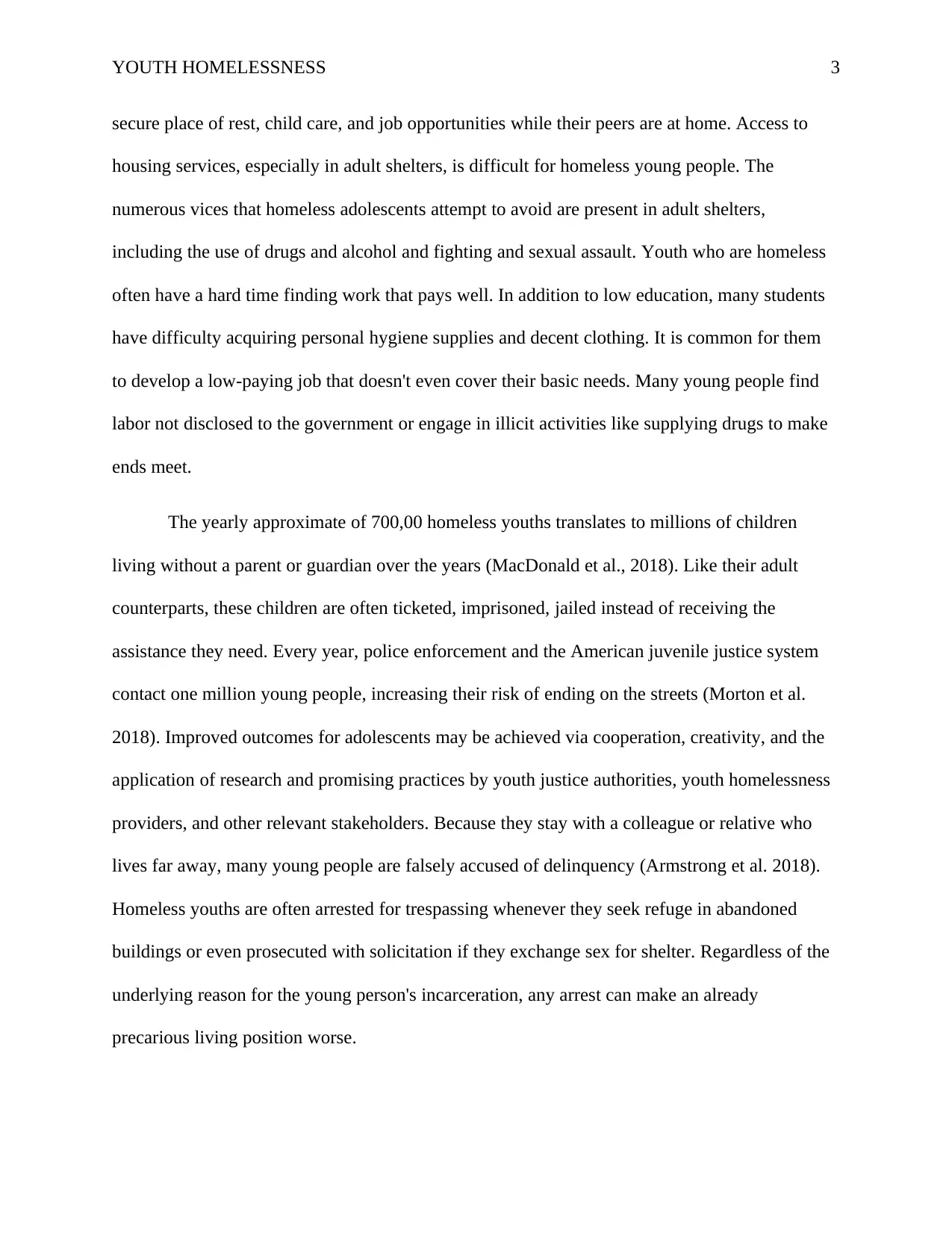
YOUTH HOMELESSNESS 3
secure place of rest, child care, and job opportunities while their peers are at home. Access to
housing services, especially in adult shelters, is difficult for homeless young people. The
numerous vices that homeless adolescents attempt to avoid are present in adult shelters,
including the use of drugs and alcohol and fighting and sexual assault. Youth who are homeless
often have a hard time finding work that pays well. In addition to low education, many students
have difficulty acquiring personal hygiene supplies and decent clothing. It is common for them
to develop a low-paying job that doesn't even cover their basic needs. Many young people find
labor not disclosed to the government or engage in illicit activities like supplying drugs to make
ends meet.
The yearly approximate of 700,00 homeless youths translates to millions of children
living without a parent or guardian over the years (MacDonald et al., 2018). Like their adult
counterparts, these children are often ticketed, imprisoned, jailed instead of receiving the
assistance they need. Every year, police enforcement and the American juvenile justice system
contact one million young people, increasing their risk of ending on the streets (Morton et al.
2018). Improved outcomes for adolescents may be achieved via cooperation, creativity, and the
application of research and promising practices by youth justice authorities, youth homelessness
providers, and other relevant stakeholders. Because they stay with a colleague or relative who
lives far away, many young people are falsely accused of delinquency (Armstrong et al. 2018).
Homeless youths are often arrested for trespassing whenever they seek refuge in abandoned
buildings or even prosecuted with solicitation if they exchange sex for shelter. Regardless of the
underlying reason for the young person's incarceration, any arrest can make an already
precarious living position worse.
secure place of rest, child care, and job opportunities while their peers are at home. Access to
housing services, especially in adult shelters, is difficult for homeless young people. The
numerous vices that homeless adolescents attempt to avoid are present in adult shelters,
including the use of drugs and alcohol and fighting and sexual assault. Youth who are homeless
often have a hard time finding work that pays well. In addition to low education, many students
have difficulty acquiring personal hygiene supplies and decent clothing. It is common for them
to develop a low-paying job that doesn't even cover their basic needs. Many young people find
labor not disclosed to the government or engage in illicit activities like supplying drugs to make
ends meet.
The yearly approximate of 700,00 homeless youths translates to millions of children
living without a parent or guardian over the years (MacDonald et al., 2018). Like their adult
counterparts, these children are often ticketed, imprisoned, jailed instead of receiving the
assistance they need. Every year, police enforcement and the American juvenile justice system
contact one million young people, increasing their risk of ending on the streets (Morton et al.
2018). Improved outcomes for adolescents may be achieved via cooperation, creativity, and the
application of research and promising practices by youth justice authorities, youth homelessness
providers, and other relevant stakeholders. Because they stay with a colleague or relative who
lives far away, many young people are falsely accused of delinquency (Armstrong et al. 2018).
Homeless youths are often arrested for trespassing whenever they seek refuge in abandoned
buildings or even prosecuted with solicitation if they exchange sex for shelter. Regardless of the
underlying reason for the young person's incarceration, any arrest can make an already
precarious living position worse.
⊘ This is a preview!⊘
Do you want full access?
Subscribe today to unlock all pages.

Trusted by 1+ million students worldwide
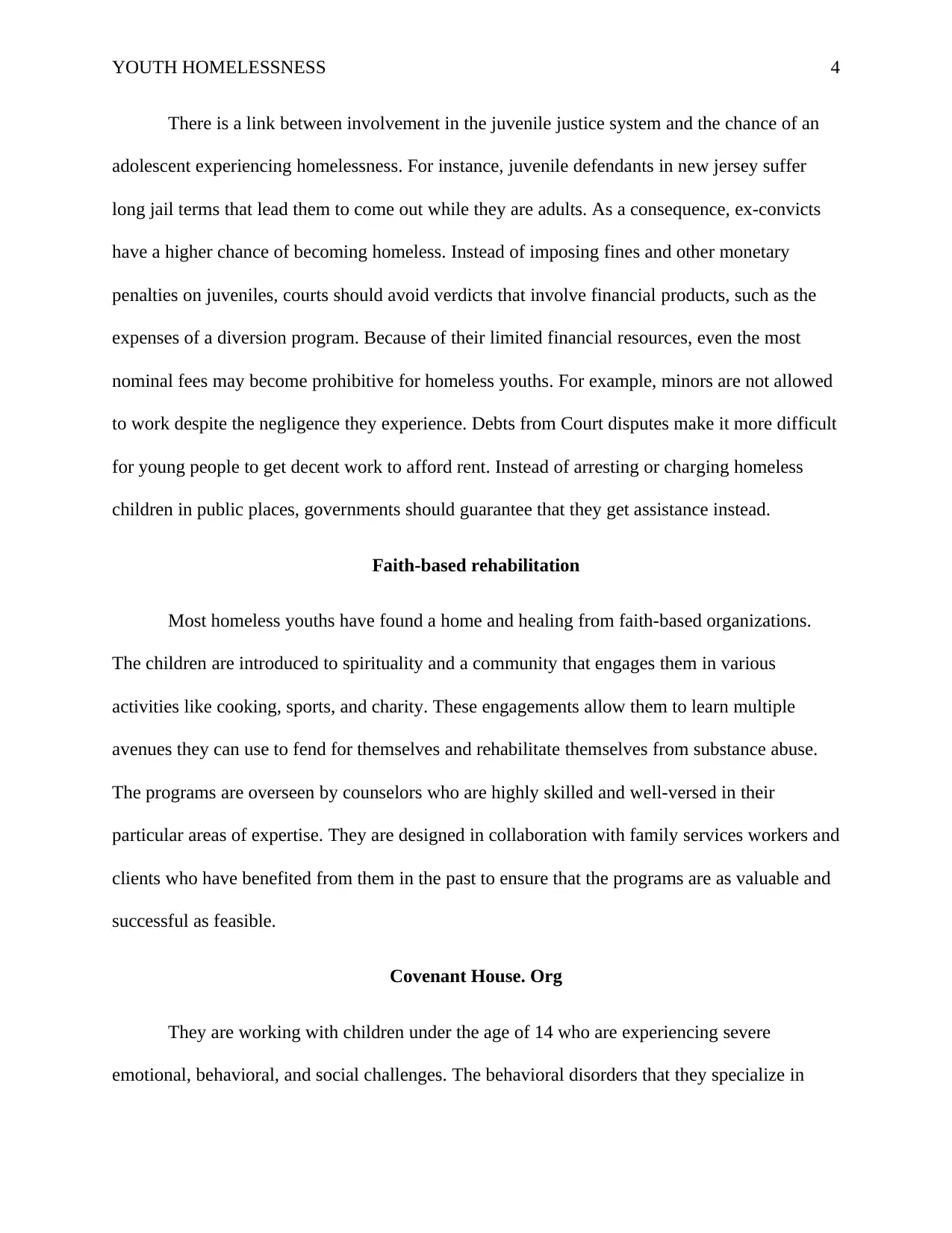
YOUTH HOMELESSNESS 4
There is a link between involvement in the juvenile justice system and the chance of an
adolescent experiencing homelessness. For instance, juvenile defendants in new jersey suffer
long jail terms that lead them to come out while they are adults. As a consequence, ex-convicts
have a higher chance of becoming homeless. Instead of imposing fines and other monetary
penalties on juveniles, courts should avoid verdicts that involve financial products, such as the
expenses of a diversion program. Because of their limited financial resources, even the most
nominal fees may become prohibitive for homeless youths. For example, minors are not allowed
to work despite the negligence they experience. Debts from Court disputes make it more difficult
for young people to get decent work to afford rent. Instead of arresting or charging homeless
children in public places, governments should guarantee that they get assistance instead.
Faith-based rehabilitation
Most homeless youths have found a home and healing from faith-based organizations.
The children are introduced to spirituality and a community that engages them in various
activities like cooking, sports, and charity. These engagements allow them to learn multiple
avenues they can use to fend for themselves and rehabilitate themselves from substance abuse.
The programs are overseen by counselors who are highly skilled and well-versed in their
particular areas of expertise. They are designed in collaboration with family services workers and
clients who have benefited from them in the past to ensure that the programs are as valuable and
successful as feasible.
Covenant House. Org
They are working with children under the age of 14 who are experiencing severe
emotional, behavioral, and social challenges. The behavioral disorders that they specialize in
There is a link between involvement in the juvenile justice system and the chance of an
adolescent experiencing homelessness. For instance, juvenile defendants in new jersey suffer
long jail terms that lead them to come out while they are adults. As a consequence, ex-convicts
have a higher chance of becoming homeless. Instead of imposing fines and other monetary
penalties on juveniles, courts should avoid verdicts that involve financial products, such as the
expenses of a diversion program. Because of their limited financial resources, even the most
nominal fees may become prohibitive for homeless youths. For example, minors are not allowed
to work despite the negligence they experience. Debts from Court disputes make it more difficult
for young people to get decent work to afford rent. Instead of arresting or charging homeless
children in public places, governments should guarantee that they get assistance instead.
Faith-based rehabilitation
Most homeless youths have found a home and healing from faith-based organizations.
The children are introduced to spirituality and a community that engages them in various
activities like cooking, sports, and charity. These engagements allow them to learn multiple
avenues they can use to fend for themselves and rehabilitate themselves from substance abuse.
The programs are overseen by counselors who are highly skilled and well-versed in their
particular areas of expertise. They are designed in collaboration with family services workers and
clients who have benefited from them in the past to ensure that the programs are as valuable and
successful as feasible.
Covenant House. Org
They are working with children under the age of 14 who are experiencing severe
emotional, behavioral, and social challenges. The behavioral disorders that they specialize in
Paraphrase This Document
Need a fresh take? Get an instant paraphrase of this document with our AI Paraphraser
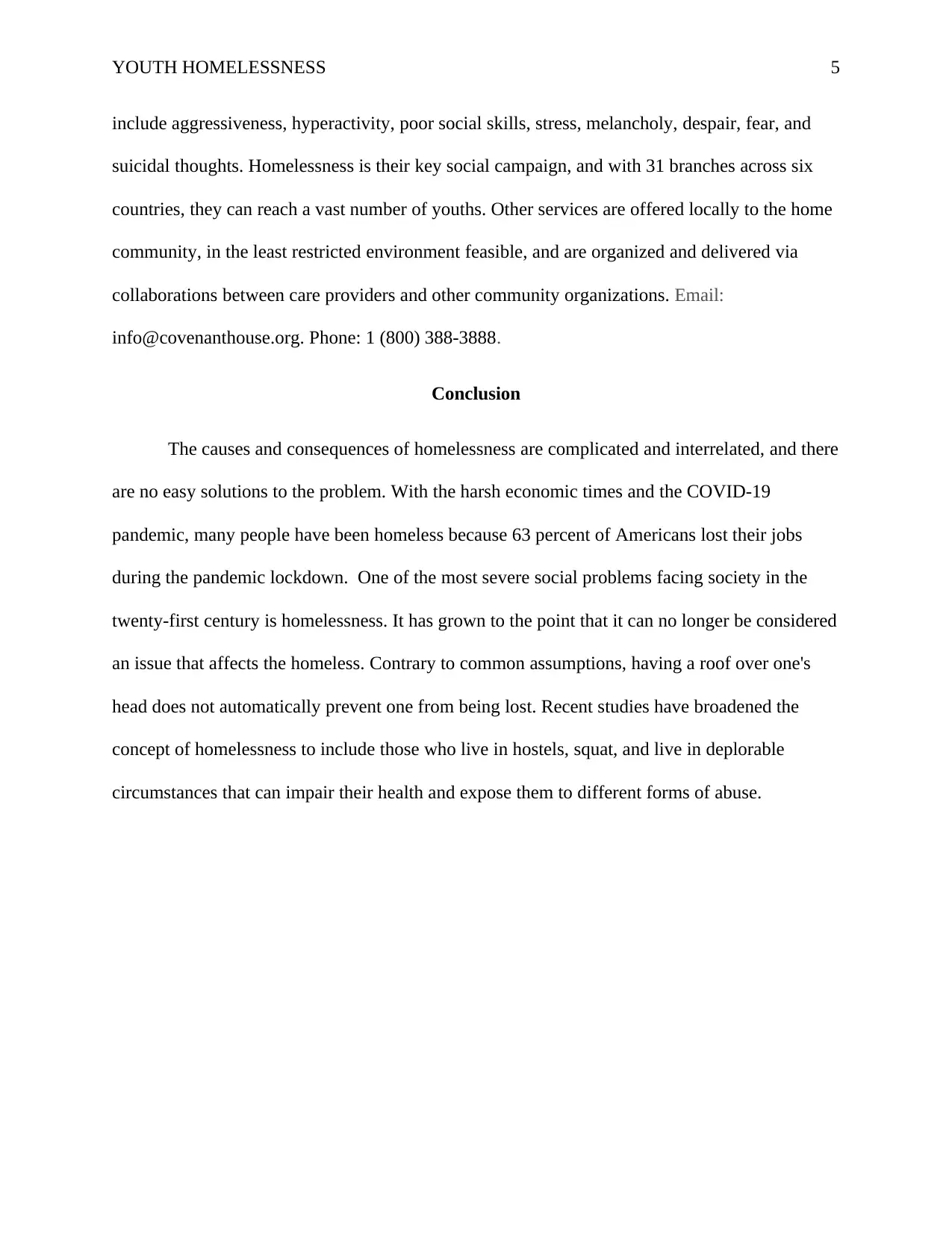
YOUTH HOMELESSNESS 5
include aggressiveness, hyperactivity, poor social skills, stress, melancholy, despair, fear, and
suicidal thoughts. Homelessness is their key social campaign, and with 31 branches across six
countries, they can reach a vast number of youths. Other services are offered locally to the home
community, in the least restricted environment feasible, and are organized and delivered via
collaborations between care providers and other community organizations. Email:
info@covenanthouse.org. Phone: 1 (800) 388-3888.
Conclusion
The causes and consequences of homelessness are complicated and interrelated, and there
are no easy solutions to the problem. With the harsh economic times and the COVID-19
pandemic, many people have been homeless because 63 percent of Americans lost their jobs
during the pandemic lockdown. One of the most severe social problems facing society in the
twenty-first century is homelessness. It has grown to the point that it can no longer be considered
an issue that affects the homeless. Contrary to common assumptions, having a roof over one's
head does not automatically prevent one from being lost. Recent studies have broadened the
concept of homelessness to include those who live in hostels, squat, and live in deplorable
circumstances that can impair their health and expose them to different forms of abuse.
include aggressiveness, hyperactivity, poor social skills, stress, melancholy, despair, fear, and
suicidal thoughts. Homelessness is their key social campaign, and with 31 branches across six
countries, they can reach a vast number of youths. Other services are offered locally to the home
community, in the least restricted environment feasible, and are organized and delivered via
collaborations between care providers and other community organizations. Email:
info@covenanthouse.org. Phone: 1 (800) 388-3888.
Conclusion
The causes and consequences of homelessness are complicated and interrelated, and there
are no easy solutions to the problem. With the harsh economic times and the COVID-19
pandemic, many people have been homeless because 63 percent of Americans lost their jobs
during the pandemic lockdown. One of the most severe social problems facing society in the
twenty-first century is homelessness. It has grown to the point that it can no longer be considered
an issue that affects the homeless. Contrary to common assumptions, having a roof over one's
head does not automatically prevent one from being lost. Recent studies have broadened the
concept of homelessness to include those who live in hostels, squat, and live in deplorable
circumstances that can impair their health and expose them to different forms of abuse.
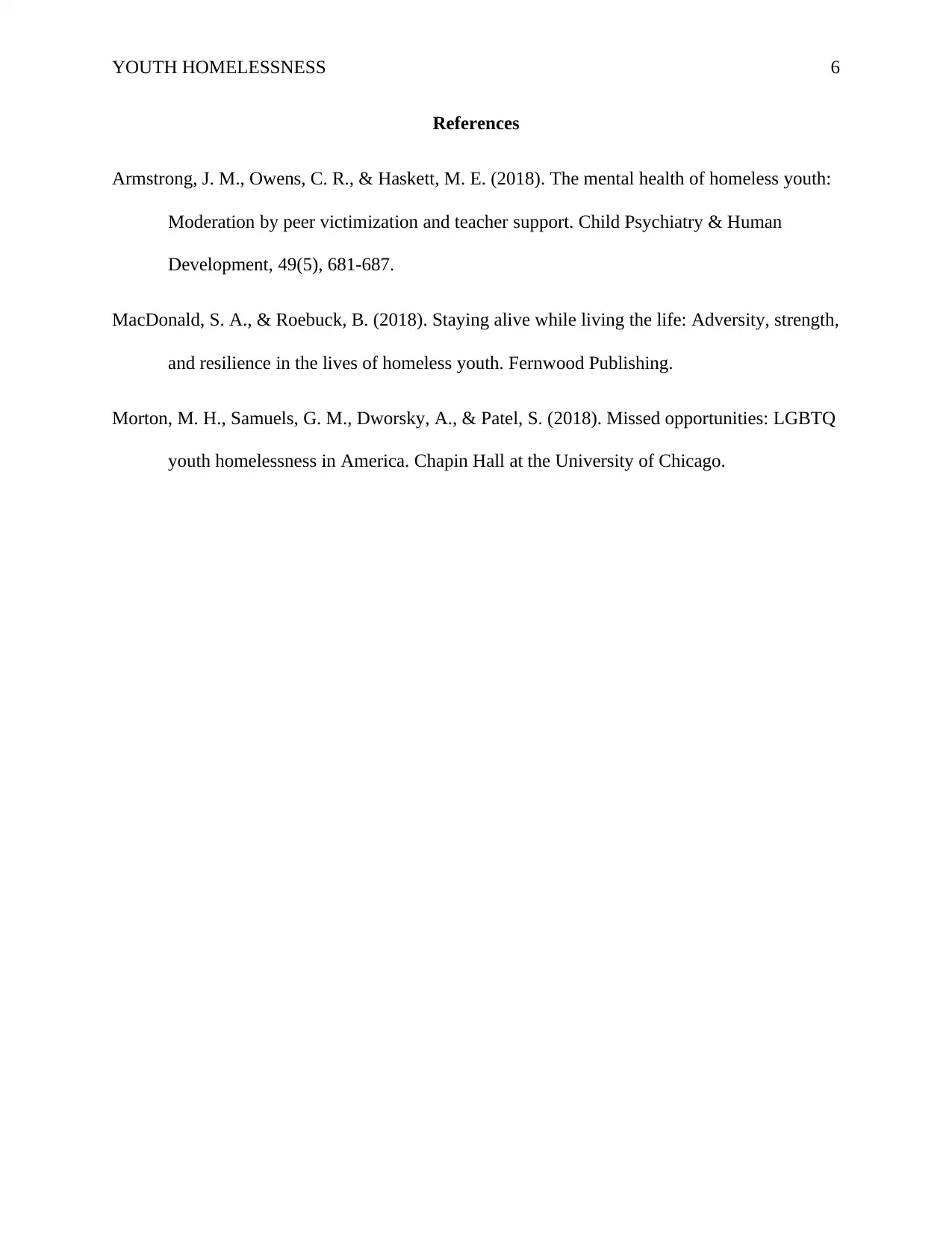
YOUTH HOMELESSNESS 6
References
Armstrong, J. M., Owens, C. R., & Haskett, M. E. (2018). The mental health of homeless youth:
Moderation by peer victimization and teacher support. Child Psychiatry & Human
Development, 49(5), 681-687.
MacDonald, S. A., & Roebuck, B. (2018). Staying alive while living the life: Adversity, strength,
and resilience in the lives of homeless youth. Fernwood Publishing.
Morton, M. H., Samuels, G. M., Dworsky, A., & Patel, S. (2018). Missed opportunities: LGBTQ
youth homelessness in America. Chapin Hall at the University of Chicago.
References
Armstrong, J. M., Owens, C. R., & Haskett, M. E. (2018). The mental health of homeless youth:
Moderation by peer victimization and teacher support. Child Psychiatry & Human
Development, 49(5), 681-687.
MacDonald, S. A., & Roebuck, B. (2018). Staying alive while living the life: Adversity, strength,
and resilience in the lives of homeless youth. Fernwood Publishing.
Morton, M. H., Samuels, G. M., Dworsky, A., & Patel, S. (2018). Missed opportunities: LGBTQ
youth homelessness in America. Chapin Hall at the University of Chicago.
⊘ This is a preview!⊘
Do you want full access?
Subscribe today to unlock all pages.

Trusted by 1+ million students worldwide
1 out of 6
Related Documents
Your All-in-One AI-Powered Toolkit for Academic Success.
+13062052269
info@desklib.com
Available 24*7 on WhatsApp / Email
![[object Object]](/_next/static/media/star-bottom.7253800d.svg)
Unlock your academic potential
Copyright © 2020–2025 A2Z Services. All Rights Reserved. Developed and managed by ZUCOL.





